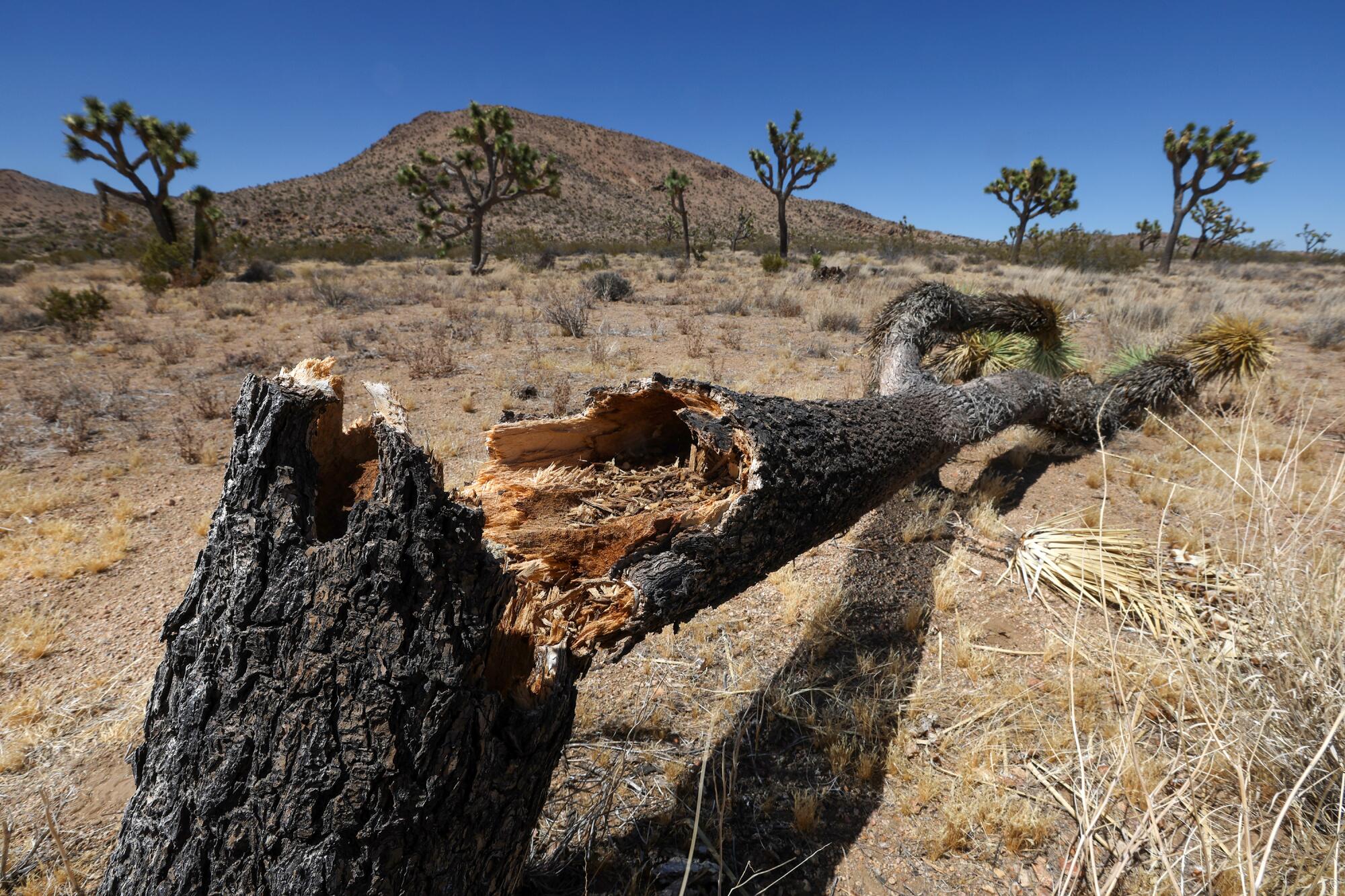
- Share via
JOSHUA TREE NATIONAL PARK — Rain in California had become like an old friend who seldom dropped in, and, then, all of a sudden showed up last fall and wouldn’t leave. Atmospheric rivers lined up off the coast and pounded the state like sets of massive waves.
This had me wondering about the forlorn trees and plants I’d seen two years ago in Joshua Tree National Park, dying of thirst.
Might the rain have given them a shot at survival?

For the answer, I reached out to Jim Cornett, an ecologist who has studied and written about desert plants and wildlife for decades. Cornett lives in Palm Springs, against the base of the Santa Rosa and San Jacinto mountains, where he got more than 8 inches of rain in the season that began last October.
If the Golden State is going to lead the world toward a better, safer future, our political and business leaders — and the rest of us — will have to work harder to rewrite the California narrative. Here’s how we can push the state forward.
That’s a few inches above normal, and spring delivered a resurgence of plant and wildlife to Cornett’s neighborhood. He hoped the same might have happened in the park, but when he traveled to the southeastern entrance to Joshua Tree National Park the first week of April, all he found was disappointment.
“No wildflowers,” he said. “The ocotillos weren’t in leaf, and one more had died. There was another drought year here.”
I met up with Cornett in the park toward the end of May, several weeks before a devastating wildfire torched an untold number of Joshua trees in Mojave National Preserve, a couple of hours to the north. As we surveyed the dusty expanse of struggling plants, I asked what happened to all those storms that rolled through California.
“By the time they got over the mountains, they had nothing left for the desert,” Cornett said.
So the outlook is no better than it was in 2021, when I first toured the park and Cornett issued a blunt assessment of the catastrophic transformation of the desert.
Here’s the headline that ran with that column:
“Imagine no Joshua trees in Joshua Tree National Park”
That won’t happen in my lifetime, but it’s the direction we’re headed in, as evidenced by research from Cornett and other authorities. The National Park Service warns of dramatic change due “in large part to human-caused climate change.”
Drought and deluge are both byproducts of climate change, but there’s little of the latter in the desert. The park service says the annual precipitation in Joshua Tree dropped 39% between 1895 and 2016, and average temperatures rose 3 degrees.
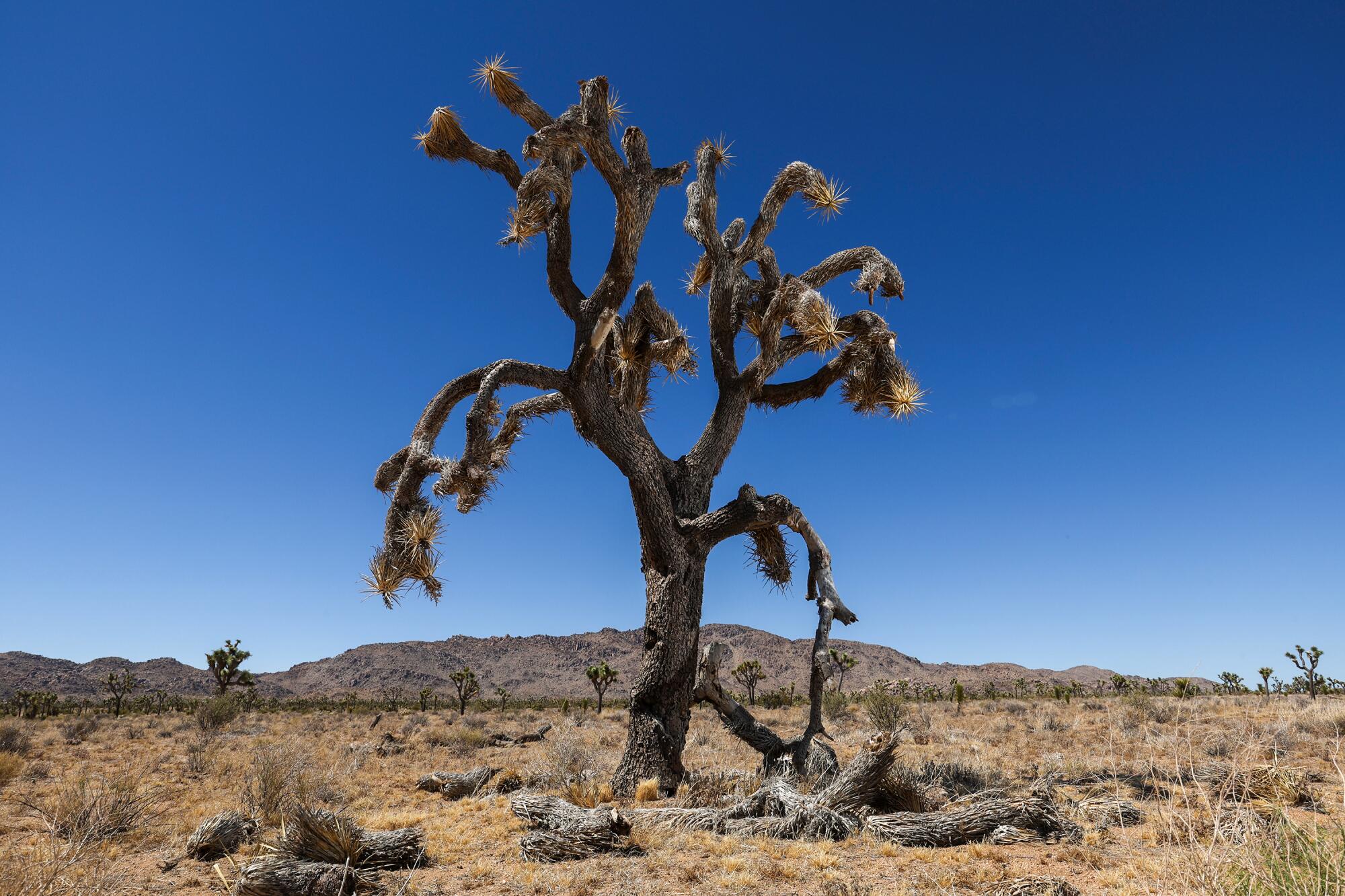
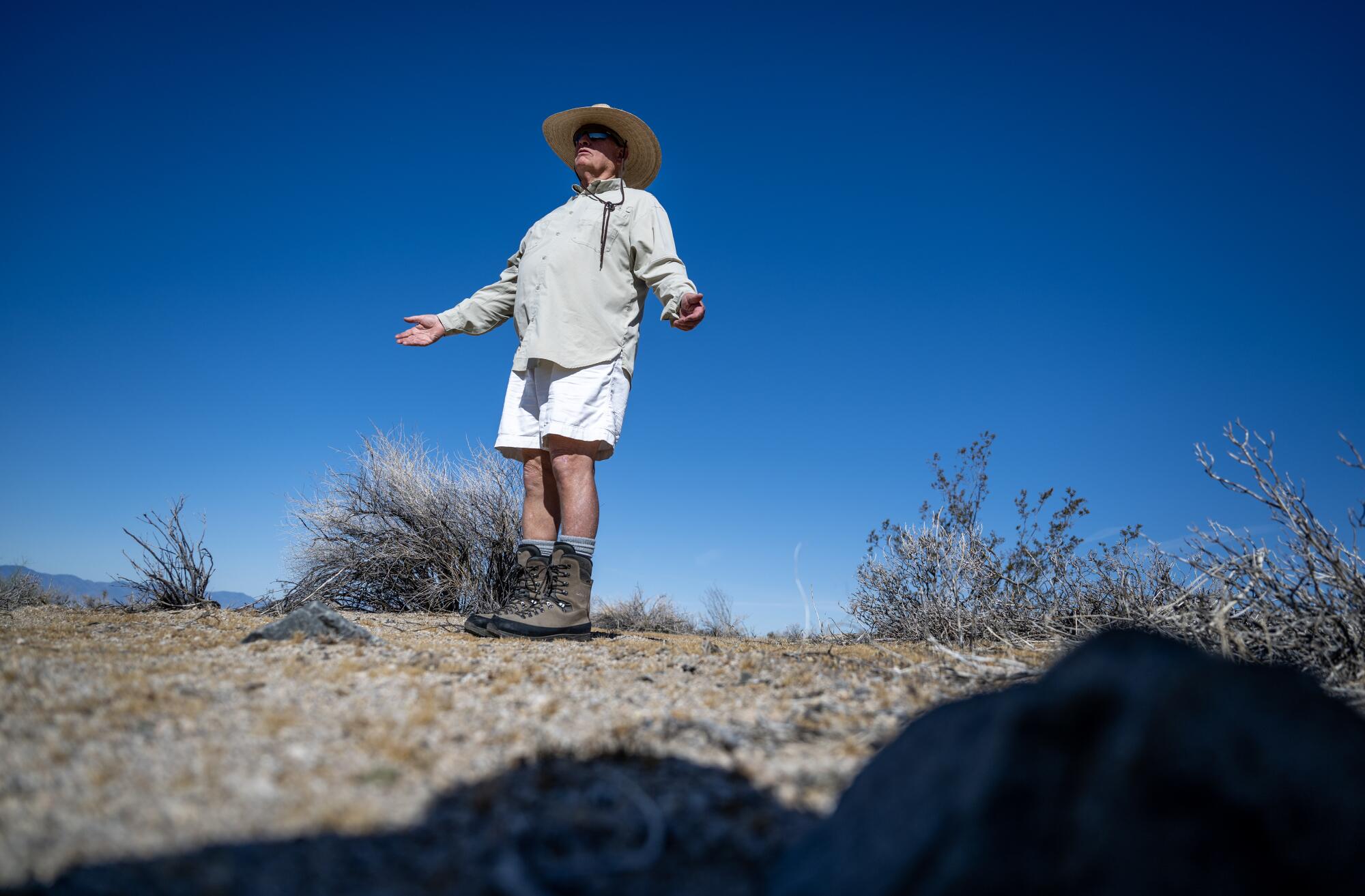
At lower elevations, “fewer seedlings are sprouting, growing and surviving,” and with continued greenhouse gas emissions, by 2099, the park website warns, 80% to 90% of Joshua tree habitat could be lost.
Californians have disagreed for years over whether to list the iconic, gnarly fisted Joshua trees as threatened under the state Endangered Species Act, with some arguing that the trees are unthreatened in cooler and wetter regions. The newly enacted Western Joshua Tree Conservation Act, meanwhile, aims to balance the interests of conservationists and developers of renewable energy and housing projects.
But to Cornett, the bigger issue is the unchecked global warming threat, and he has been a witness to the devastation, having tagged and monitored Joshua trees in the park since 1988, and ocotillo plants since 2007. He repeatedly revisits his study sites, and, like a doctor taking vital statistics, records signs of both life and death, entering data into a field computer.
In that time, he has seen no positive trends. Even farther north, at Lee Flat in Death Valley — where Joshua trees were in far greater health with cooler temperatures and more moisture — Cornett has seen no new growth. As for the youngest trees, he said, “I don’t think they’re going to make it through the summer.”
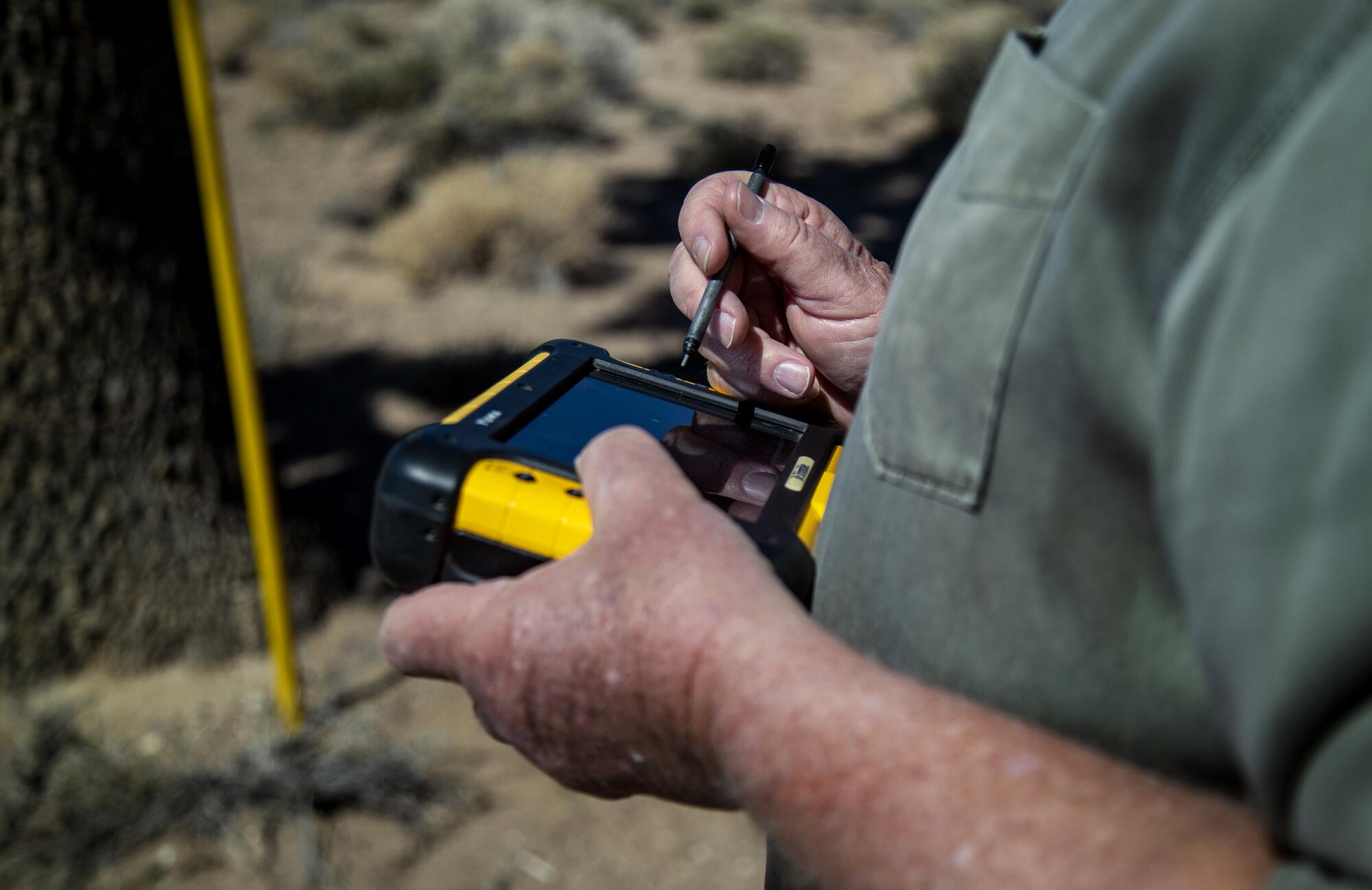
Unfortunately, it’s not just Joshua trees and ocotillo that are suffering. They’re part of an entire ecosystem — dozens of bird species nest in Joshua trees —that’s in peril, and Cornett studies the big picture, as well.
No rain means no wildflowers, which means no dropped seeds, which means fewer rodents, snakes and birds.
The Joshua tree is a keystone species whose demise threatens a host of animals that rely on it for food, moisture and shelter.
When ocotillo are too gravely ill to flower, there’s no nectar for hummingbirds migrating north from Mexico.

“Everywhere you look, you can see a dead ocotillo,” Cornett said as we surveyed our surroundings south of the park’s Cottonwood Visitor Center.
A few plants had half-hearted blossoms or specks of green, but Cornett pointed out the many bare, damaged limbs. That, he said, was the work of antelope squirrels and desert wood rats that had braved the sharp needles grown by ocotillo for self-protection.
“You have to be pretty desperate to tackle this,” Cornett said, examining a spiny limb. “But look, this is where a rodent has chewed through the bark to get at the moist cambium layer in each stem and get a little moisture.”
California has enacted the Western Joshua Tree Conservation Act, which is aimed at helping to ensure the survival of millions of the climate-threatened trees.
The same was true of the damage done, about 20 miles away, at one of Cornett’s Joshua tree study sites. When he began visiting the Queen Valley area in 1988, Cornett said, he tagged 68 trees for monitoring. By 2007, about 15 had died of drought-related causes; then a fire sparked by lightning killed dozens more.
Today, only a handful of struggling Joshua trees remain upright.
“No new Joshua trees have come up. Not a single one,” Cornett said of his 35-year study. “The fire speeded up what climate change was already doing.”
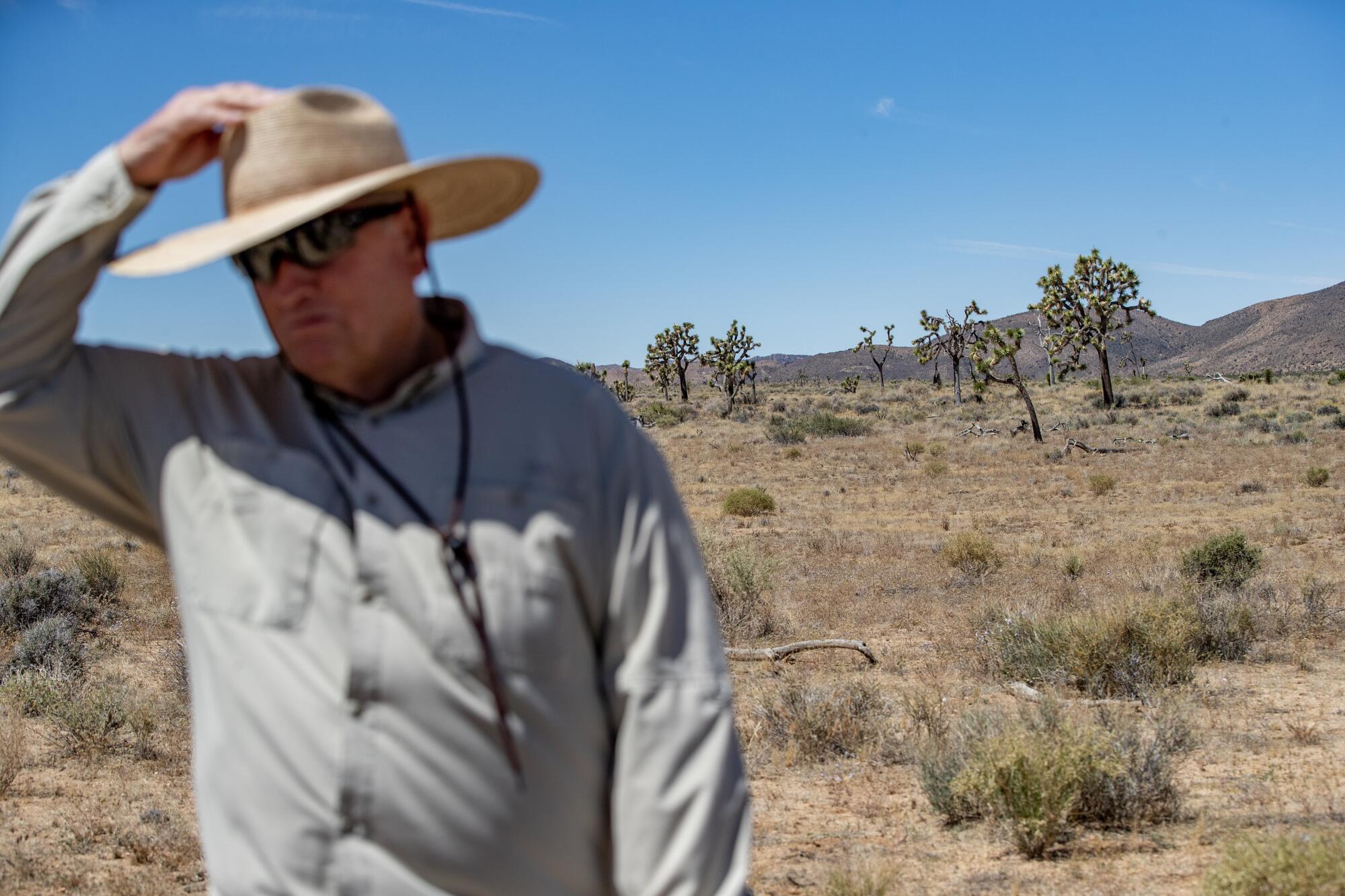
Cornett’s latest book, scheduled for publication later this year, is titled “The California Deserts: Then and Now.” It’s a before-and-after photo essay compilation of the disturbing transformation, with more death on the horizon.
Steve Lopez
Steve Lopez is a California native who has been a Los Angeles Times columnist since 2001. He has won more than a dozen national journalism awards and is a four-time Pulitzer finalist.
“We could be doing something about it, but you know, we’re supposed to be [cutting] carbon dioxide … and emissions go up every year,” said Cornett, who blames overpopulation and overuse of resources.
The park website insists there’s still hope if we accelerate conversion to wind and solar power, switch to energy-efficient appliances and electric vehicles, reduce consumption and eat less meat. “Will you help be part of the change?” the website asks.
Every little bit helps, Cornett said. But maybe, he joked, the only answer is to figure out a way to escape to a planet “someplace out there in the heavens” — a place that hasn’t yet been spoiled.
“Someday,” he said, “there’ll be tours to go see Earth, and see what people did to it.”
steve.lopez@latimes.com
Ask a Reporter: Inside the project
What: Times reporters Rosanna Xia and Sammy Roth will discuss “Our Climate Change Challenge” during a live streaming conversation. City Editor Maria L. LaGanga moderates.
When: Sept. 19 at 6 p.m. Pacific.
Where: This free event will be live streaming. Sign up on Eventbrite for watch links and to share your questions and comments.
More to Read
Sign up for Essential California
The most important California stories and recommendations in your inbox every morning.
You may occasionally receive promotional content from the Los Angeles Times.

















